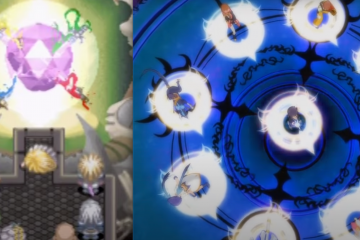It is possible that I have spent too much time arguing with people who categorically refuse to admit that video games have literary value comparable to that of a novel or film. I say “too much time” because, to me, this is an untenable position for anyone who has actually spent a significant amount of time engaging video games to hold; that leads me to believe that most people who hold on to this view are espousing something like willful ignorance of the value of video games.
But I don’t presently want to pursue the general arguments against such an opponent. Rather, I want to use a common complaint that I hear from people like this as a jumping-off point for exploring something that most gamers take for granted, but which is also a very special feature of video games as a medium: replay value.
The complaint, in its best-articulated form, is as follows: ‘games often prompt their players to waste time by playing them more than once — i.e., replaying them. Even if one accepts that games are valuable, this replay time could better be spent by playing an entirely different game. Just as there are too many quality books to justify spending a large amount of time reading the same books many times, there are too many games to justify playing a game more than once.’
The motivating idea here is that video games are unnecessary time sinks because they somehow entice players to play the same game many times, which can amount to 2x or 3x (or more) time spent on the game, in comparison with a single playthrough. As you can probably guess, this line of reasoning doesn’t impress me; however, understanding where this reasoning comes from will ultimately be useful, both in helping us understand why common misconceptions like this arise, and in better understanding why video games are unique.
Let’s start with the comparison that the complaint makes between video games and books. I think it’s fair to say that some sort of comparison of this type is commonly either explicitly or implicitly used in the reasoning of people who object to video games in this way. Say that someone has been thoroughly convinced that video games can, in fact, tell a story — “Yes, Grandma, these collections of pixels on the screen named ‘Cloud’ and ‘Tifa’ actually have just as much of a story behind them as Frodo and Gandalf” — yet that person has still never actually played a video game. What we would expect is that such a person would expect the storytelling of games to operate in a way similar to that of a book or a film. Until shown otherwise, it’s a fairly natural assumption that storytelling, on a fundamental level, is the same across various media; more to the point, if you only watch someone playing a game, as opposed to playing it yourself, then the game will looks in most ways like a movie: sound effects, graphics, and dialogue evolving on a television screen.

So, our imagined Grandma compares video games with books — fair enough. Now the pressing question is: when are “rereads” of books typically valuable? Well, you might say that the same book can be valuable when read with different goals in mind — reading Herodotus, say, as literature, versus reading him for sociopolitical context — but, assuming that one has thoroughly read a book, it is unlikely that the book would have to be literally reread in order to consider it in multiple contexts. More often, I would offer, it is the case that reading a book multiple times is valuable when one rereads the book after a substantial amount of time has passed since the first reading. The motivation here, rather than any intrinsic change in the book, is change in the reader’s perspective: for instance, one would most likely have a different perspective on Shakespeare’s King Lear when reading it as a father of three grown women, versus reading it decades earlier in college.
This change in reader perspective is central to ‘reread value’ because the text of a book is fixed — it is not as though, like Borges’ Book of Sand, the book is literally different each time a person opens it. And this is where Grandma’s reasonable assumption of relating video games to books becomes untenable: it is not the case that the same video game presents a literally identical analogue to text each time a person plays it. The reason why this is the case is because video games present the player with a matrix of possible choices: the player can perform different actions with her avatar, which establishes a degree of freedom that lacks analogue in books or films (for a more precise treatment of this, see my presentation of narrative three-space as explained in this paper on “Dishonored”). It is this degree of freedom that turns a single video game into a compendium of many possible versions of one overarching “story.”
The extra degree of freedom afforded video games completely changes the dynamics of engaging the same narrative multiple times — and it does so both in microscopic and macroscopic ways. On the microscopic level, consider a game with a perfectly linear storyline: even in a case such as this, it is not the case that any two playthroughs will be exactly the same. For instance, one may acquire different items, have different battle encounters with enemies, and may die at different points. This element of distinctness makes each playthrough of a game phenomenologically distinct in a way dissimilar to ‘readthroughs’ of books: even though the overarching story of a game may be the same, the potential for microscopic outcomes, such as those listed above, to differ in accordance with the player’s input affords games a sense of spontaneity and experience on the part of the player that the reader of a book will not have. Each time through a game really is different; and even if the difference is only marginal, this is a type distinction sufficient to justify a replay on different grounds than a reread.

But the distinction is even more obvious in the cases of games whose mechanics create differences in playthroughs on a macroscopic narrative level. In such cases, the outcome of the game may actually vary hugely from playthrough to playthrough. Consider a case like “Chrono Trigger,” which features a huge variety of different outcomes to events based on the choices made by the player (“Chrono Trigger,” more to the point, coined the term “New Game Plus,” implying that something is actually gained by playing the game more than once). More recently, “Dishonored” offered two mutually incompatible evolutions of its world, based on choices made by the player during the course of a playthrough — so, in order to see the totality of all possible versions of the game’s world, you must play through the game more than once. A personal favorite (and, in my view, highly underrated) game, “Nier” actually features four distinct, sequential endings, with each accompanying playthrough providing the player with a substantively distinct conception of the world and story of the game. The structure of the game is actually such that a player who only plays through the game once will overlook more than half of the story being told by the game.
What’s ultimately important here is that the misconception Grandma made is totally understandable, because it rests on an assumption about the fixedness of the content of a piece of art that usually makes sense. What’s interesting about video games, then, is that we see that making this assumption leads us down a totally wrong road in terms of how video games function. Moreover, besides video games being different from other media, I would suggest that they change how we expect to engage a work of art. When there are some stories — that is, those of video games — which we must go through more than once in order to fully appreciate, could we not say that stories that can be entirely conveyed in a single reading are, in some importantly way, less substantive? Keep this in mind the next time someone complains about you playing “the same old game” — and, perhaps more to the point, the next time you’re frustrated at games costing two-to-three times as much as books (horribly overpriced though both may be), remember that, in this way, you are actually getting two-to-three times as much of a story.



